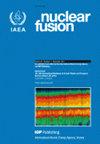更正:氘氚磁聚变中的氚燃烧效率(2023 Nucl.)
IF 4
1区 物理与天体物理
Q1 PHYSICS, FLUIDS & PLASMAS
引用次数: 0
摘要
有关氚燃烧效率(TBE)的控制参数是根据第一原理推导出来的,并表明这些参数主要取决于分流器中允许的氦气分量以及氦灰和未燃烧氢燃料的有效抽速。该分析适用于任何使用分流器排出粒子的平衡磁核聚变等离子体。由于核心等离子体中的灰稀释效应与聚变性能之间存在联系,等离子体中的 He 气体组分限制了最大 TBE。磁核聚变装置中的高 TBE 与实现商业核聚变的高增益和高功率密度是背道而驰的。本文得出了 TBE 对核聚变性能的影响,包括功率密度、所需乘积和等离子体能量增益。根据已公布的富集数据和研究托卡马克的数据,本文提出的 TBE 方案适用于现有装置。这一评估有力地推动了对能够提高等离子体中氦到燃料的有效泵送速度的技术的探索。本文章由计算机程序翻译,如有差异,请以英文原文为准。
Corrigendum: Tritium burn efficiency in deuterium–tritium magnetic fusion (2023 Nucl. Fusion 63 126019)
The controlling parameters regarding tritium burn efficiency (TBE) are derived from first principles and shown to depend fundamentally on the permitted He gas fraction in the divertor and effective pumping speeds of He ash and unburned hydrogenic fuel. The analysis is generic to any equilibrated magnet fusion plasma using a divertor for particle exhaust. The He gas fraction in the plasma limits the maximum TBE due to the link between ash dilution effects in the core plasma and fusion performance. High TBE in magnetic fusion devices is counter-correlated to achieving high gain and power density for commercial fusion. The impact of TBE on fusion performance for several figures of merit are derived, including power density, required product, and plasma energy gain . The TBE formulation presented here is applied to existing devices, based on published data of enrichment and from research tokamaks. This assessment strongly motivates exploration of technologies that would enhance the effective pumping speed of He to fuel out of the plasma.
求助全文
通过发布文献求助,成功后即可免费获取论文全文。
去求助
来源期刊

Nuclear Fusion
物理-物理:核物理
CiteScore
6.30
自引率
39.40%
发文量
411
审稿时长
2.6 months
期刊介绍:
Nuclear Fusion publishes articles making significant advances to the field of controlled thermonuclear fusion. The journal scope includes:
-the production, heating and confinement of high temperature plasmas;
-the physical properties of such plasmas;
-the experimental or theoretical methods of exploring or explaining them;
-fusion reactor physics;
-reactor concepts; and
-fusion technologies.
The journal has a dedicated Associate Editor for inertial confinement fusion.
 求助内容:
求助内容: 应助结果提醒方式:
应助结果提醒方式:


